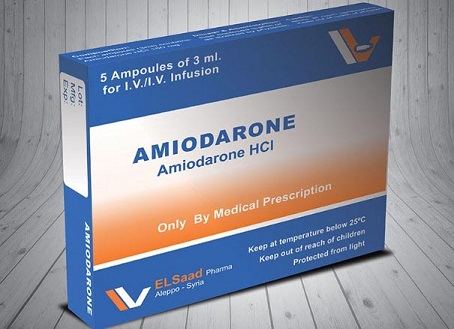A deep dive into atrial fibrillation management and the usage of Amiodarone in septic shock patients
Charles Tee Fact checked by:Thailand Medical News Team Sep 06, 2024 1 year, 3 months, 2 weeks, 6 days, 6 hours, 5 minutes ago
Medical News: The management of new-onset atrial fibrillation (NOAF) in patients experiencing septic shock is a critical area of concern in intensive care units (ICUs). With high mortality rates associated with sepsis and septic shock, finding the most effective treatment for cardiac complications like NOAF is crucial. Recent research sheds light on the role of amiodarone in treating NOAF in septic patients, offering new insights into its efficacy and safety.
 A deep dive into atrial fibrillation management and the usage of Amiodarone in septic shock patients
The Challenge of NOAF in Septic Shock
A deep dive into atrial fibrillation management and the usage of Amiodarone in septic shock patients
The Challenge of NOAF in Septic Shock
Septic shock is a severe and often fatal condition, characterized by an overwhelming immune response to infection, leading to systemic inflammation, organ failure, and dangerously low blood pressure. NOAF, a type of arrhythmia, frequently complicates the course of septic shock. The incidence of NOAF in septic patients is alarmingly high, with studies indicating that up to 46% of septic shock patients may develop this condition. This poses significant challenges in the ICU, as the management of both sepsis and NOAF requires careful balancing of treatments that do not exacerbate either condition.
Understanding Amiodarone: A Double-Edged Sword?
Amiodarone, a widely used antiarrhythmic medication, has been at the forefront of treating supraventricular arrhythmias like NOAF. It works by blocking calcium channels and beta-receptors, thereby controlling heart rate and maintaining sinus rhythm. However, the administration of amiodarone in septic patients is not without risks. Concerns about its impact on hemodynamics, particularly in patients with compromised cardiac function, have led to ongoing debates about its safety and efficacy.
This
Medical News report aims to evaluate the role of amiodarone in managing NOAF in septic shock, based on a comprehensive review of recent studies conducted by researchers from “Dunărea de Jos” University in Galati, Romania. The review provides critical insights into the benefits and potential drawbacks of using amiodarone in this vulnerable patient population.
Key Findings on Amiodarone Use in Septic Shock
-Efficacy in Restoring Sinus Rhythm
Recent studies have shown that amiodarone can be effective in restoring sinus rhythm in septic patients with NOAF. Specifically, for patients with pre-existing cardiac conditions, such as a dilated left atrium, amiodarone appears to offer significant benefits. It not only helps in maintaining sinus rhythm but also does so with fewer adverse effects compared to other antiarrhythmic drugs.
-Comparative Effectiveness
The reviewed studies compared amiodarone with other antiarrhythmics like propafenone. Interestingly, while propafenone demonstrated quicker cardioversion times in some cases, amiodarone was more effective in patients with specific cardiac conditions. This suggests that the choice of antiarrhythmic therapy should b
e tailored to the individual patient’s cardiac profile, rather than a one-size-fits-all approach.
-Safety Concerns and Hemodynamic Stability
One of the major concerns with amiodarone use in septic patients is its potential to cause hemodynamic instability. However, the studies indicated that within the first 72 hours of administration, there were no significant differences in hemodynamic changes between patients with and without septic shock. This finding is particularly important, as it suggests that amiodarone can be safely used in this population, provided that patients are closely monitored.
-Mortality and Long-Term Outcomes
The impact of amiodarone on mortality in septic shock patients remains a complex issue. While the drug is effective in restoring sinus rhythm, its use did not significantly alter 28-day or one-year mortality rates compared to other treatments. However, the studies noted that patients who did not achieve sinus rhythm had substantially higher mortality rates, emphasizing the importance of successful cardioversion in improving patient outcomes.
-Recurrent NOAF: A Persistent Challenge
Recurrence of NOAF after initial treatment with amiodarone was reported in a significant proportion of patients. This highlights the ongoing challenge of managing recurrent arrhythmias in septic shock, suggesting that alternative strategies or combination therapies may be necessary to prevent relapse.
Clinical Implications: Tailoring Treatment to Patient Needs
The findings from these studies underscore the importance of individualized treatment plans for septic shock patients with NOAF. While amiodarone remains a viable option for many patients, particularly those with specific cardiac conditions, its use should be carefully considered in the context of each patient’s overall health status and the presence of other comorbidities.
For clinicians, these insights provide valuable guidance on when and how to use amiodarone in septic shock. The decision to use amiodarone should be informed by a thorough assessment of the patient’s cardiac function, the severity of the septic shock, and the potential risks associated with the drug.
Conclusions and Future Directions
In conclusion, the use of amiodarone in septic shock patients with NOAF presents both opportunities and challenges. While it can be effective in restoring and maintaining sinus rhythm, its use must be balanced against the risk of hemodynamic instability and other potential side effects. The findings from this review suggest that amiodarone should be considered as part of a broader treatment strategy that includes careful patient monitoring and individualized care plans.
As the prevalence of NOAF in septic shock continues to rise, further research is needed to refine treatment protocols and improve patient outcomes. Future studies should focus on identifying predictors of successful cardioversion, exploring the potential benefits of combination therapies, and developing guidelines for the safe and effective use of antiarrhythmic drugs in this high-risk population.
The study findings were published in the peer-reviewed journal: Medicina.
https://www.mdpi.com/1648-9144/60/9/1436
For the latest on atrial fibrillation, keep on logging to Thailand
Medical News.
Read Also:
https://www.thailandmedical.news/news/new-study-reveals-effective-treatment-for-recent-onset-atrial-fibrillation
https://www.thailandmedical.news/news/atrial-fibrillation-significantly-increases-mortality-risk-in-severe-covid-19-cases-
https://www.thailandmedical.news/news/study-finds-that-regular-use-of-fish-oil-supplements-might-be-a-risk-factor-for-atrial-fibrillation-and-stroke
